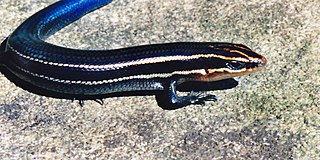Related Research Articles

In physics, the kinetic energy of an object is the form of energy that it possesses due to its motion. It is defined as the work needed to accelerate a body of a given mass from rest to its stated velocity. Having gained this energy during its acceleration, the body maintains this kinetic energy unless its speed changes. The same amount of work is done by the body when decelerating from its current speed to a state of rest. Formally, a kinetic energy is any term in a system's Lagrangian which includes a derivative with respect to time and the second term in a Taylor expansion of a particle's relativistic energy.
In physics, power is the amount of energy transferred or converted per unit time. In the International System of Units, the unit of power is the watt, equal to one joule per second. In older works, power is sometimes called activity. Power is a scalar quantity.

Rhabditida is an order of free-living, zooparasitic, and phytoparasitic microbivorous nematodes living in soil.

The four-lined skink is a species of lizard, which is endemic to North America. It is a medium-sized member of the Plestiodon skinks.

Annona is a genus of flowering plants in the pawpaw/sugar apple family, Annonaceae. It is the second largest genus in the family after Guatteria, containing approximately 166 species of mostly Neotropical and Afrotropical trees and shrubs.
In linear algebra, an eigenvector or characteristic vector of a linear transformation is a nonzero vector that changes at most by a constant factor when that linear transformation is applied to it. The corresponding eigenvalue, often represented by , is the multiplying factor.
Tylenchorhynchus dubius is a plant pathogenic nematode.
Tylenchorhynchus maximus is a plant pathogenic nematode infecting barley.
Tylenchorhynchus nudus is a plant pathogenic nematode cause dwarfing disease specially at rice plant.
Tylenchorhynchus phaseoli is a plant pathogenic nematode infecting pearl millet.
Tylenchorhynchus vulgaris is a plant pathogenic nematode infecting pearl millet.
Tylenchorhynchus zeae is a plant pathogenic nematode infecting pearl millet.
Tylenchorhynchus is a genus of nematodes including many species of plant parasites. The classification of stunt nematodes - those including the genus Tylenchorhynchus - is unstable; many newly discovered species within this genus are reconsidered to be actually subspecies. Stunt nematodes such as Tylenchorhynchus and the closely related genera, Anguillulina and Merlinia, include more than 250 known species. Members of these genera possess similar anatomy and may be easily mistaken for one another. Some debate has led to the classification of single species under different names in two distinct genera.
T. vulgaris may refer to:
A. dubia may refer to:
T. maximus may refer to:
Afroeurydemus brevilineatus is a species of leaf beetle of the Democratic Republic of the Congo, described by Martin Jacoby in 1900.

Afroeurydemus is a genus of leaf beetles in the subfamily Eumolpinae, found in Africa. The genus was separated from Eurydemus in 1965 by Brian J. Selman, who moved all African species of Eurydemus he had seen to this genus or related African genera and considered it likely that Eurydemus was restricted to Fiji. Many species were also originally placed in Syagrus.
Belonolaimidae is a family of nematodes belonging to the order Tylenchida.